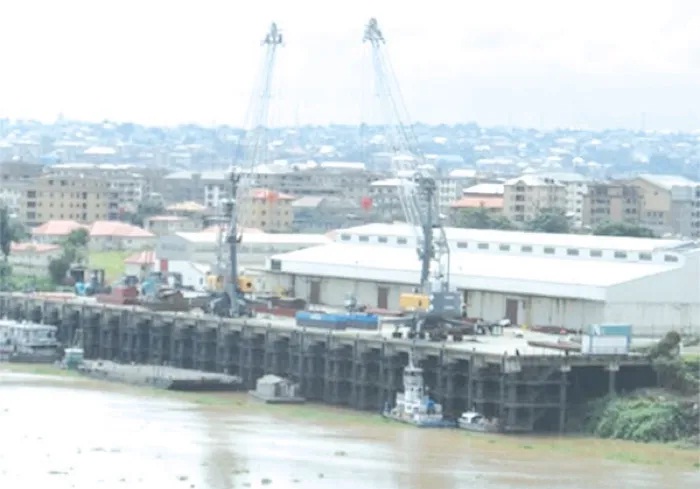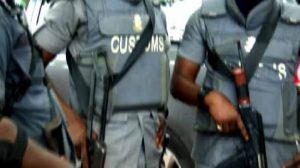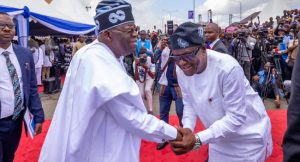Politics of chop-chop at Onitsha River Port

Is it possible that this government, like previous ones, is playing chop-chop politics with the Onitsha River Port project? This feeling grew stronger after reading something that Minister of State for Transport, Ms. Gbemisola Saraki, said last week. As an aside, she was one of two ladies that I was excited to read of their nomination by President Muhammadu Buhari. Soon after their swearing in, however, both ladies completely disappeared from the public radar. In Saraki’s case, this could have been the effect of living under the controversial and intimidating presence of senior transport minister, Chibuike Rotimi Amaechi. The cultured lady that I met briefly in the Atiku Abubakar campaign office in 2006 cannot compete at the jaguda level. Since Amaechi left the ministry to pursue his presidential ambition, she is now fully in the public eye. And she will be in this spotlight for about a year.
It is possible that she would look for one thing that will signpost her brief stay in the sun, and one would hope it is not the Onitsha River Port. Last week, the minister made a startling statement about the port project. She wagered that the port could generate N23 billion revenue in 30 years once it is given out on concession. This made one wonder whether the port will continue as a white elephant, after two previous false starts. The only difference is that this time around government plans to concession the facility. Still, there are two troubling aspects to her declaration, what it says about the viability of the project and the inconsistent representation of its earnings potential. Before we get into this, a little background information on the Onitsha River Port will clarify what may turn out as another round of chop-chop politics for the struggling port.
Nigeria established four river ports in Onitsha (Anambra), Oguta (Imo), Lokoja (Kogi) and Baro (Niger).
According to the Punch newspaper, the ports were to serve as alternative sources of transporting goods to the hinterland from Lagos, Port Harcourt and other areas with adequate water connectivity. National Inland Waterways Authority (NIWA), a parastatal of the Federal Ministry of Transport, manages all four ports. Ms. Saraki is, therefore, the big boss of Onitsha River Port.
In terms of facilities, the agency said government equipped the Onitsha port to deal with general cargo such as containers, bulk cargo, and other packaged freight. It sits on a land mass of over 12 hectares, with a wharf 324 metres long, expandable by another 234 metres. There are other facilities such as storage workshops and parking areas to cater for operations.
Why do I think that politics of chop-chop rules the Onitsha River Port project? President Shehu Shagari built and inaugurated this port with fanfare decades ago. Officials abandoned the port and left it underutilized until two decades later when the President Goodluck Jonathan administration resurrected the project. Jonathan provided more funds to rehabilitate the port. He also allegedly “wasted” N34 billion to dredge the river and free the waterways for vessels from Lagos and Port Harcourt to the hinterland. Like Shagari before him, Jonathan organized another showstopper at Onitsha to re-inaugurate the port in 2012. The current effort by President Muhammadu Buhari is, therefore, the third time that Onitsha River Port will receive massive government attention. Experts estimate that the Buhari administration has so far poured over N70 billion into the latest rehabilitation effort. This amount includes the vote for security of the waterways. As already indicated, the Infrastructure Concession Regulatory Commission (ICRC) is making efforts to concession the port to a private firm. Understandably, the agency makes it appear as if the Onitsha Port will be a money-spinner for both the concession winner and the government. According to ICRC, the 30-year concession will generate over N50 billion for government. The agency also projects that the port would create thousands of direct and indirect jobs, an important benefit. Significantly, ICRC officials believe the concession will facilitate “efficient trade within the country through cheaper, easier, and cleaner methods of transporting goods and services.”
One must, therefore, laud the Buhari administration’s efforts to make the Onitsha River Port come alive after a decade of neglect since Jonathan. It is also interesting that government will sell the facility at the end of the concession lease. Both concession and eventual sale explain why officials are making efforts to publicize and possibly exaggerate its viability. But will they succeed in closing the deal or will this turn out to be a hard sell that pushes the port into disuse once more? Are we likely to see another administration after Buhari repeat the process by pumping more billions into it and, thereafter, abandon it for future rounds of treasuring looting through phantom rehabilitation? The answers may come from paying close attention to the contradictory figures bandied about by top officials regarding the port’s viability.
ICRC announced on February 3 that the project will deliver N50 billion in earnings within 30 years. Last week, however, Ms. Saraki proposed N23 billion as potential earnings within the same period. This leaves us to wonder: How did ICRC’s original projection of N50 billion depreciate by 40 per cent in just four months? ICRC is executing the concession arrangement while Saraki’s Transport Ministry manages the facility through NIWA. So, whose potential earnings figures should prospective concessioners believe, since both Transport and ICRC are the authorities on the project? The problem is that, at the end of the day, it does not matter whom we believe. What matters is the projection from Ms. Saraki complicates the viability picture that government is trying to paint.
Broken down, the Saraki figures return annual average income of N767 million. If we were to factor the cost of operations, how much can government and the concessionaire reasonably expect to net as income on the project? One way to find out is to look at what the mother agency (NIWA) currently spends on its operations. Although current figures are not available, N760 million was the annual cost of running the agency a decade ago! One can only speculate what it will be today, 10 years after. What this means is that the elephant in the room will be the cost of maintaining the port.
There are three hindrances to the smooth operations of our river ports, the navigation reliability of the river routes, security along the routes and the seacrafts that ply the routes.
The concession winner needs smooth access from Onitsha to Warri and Port Harcourt. This requires dredging the River Niger and Benue from Baro, Lokoja, Onitsha and Oguta to the sea. Over time, this has proved to be a drainpipe and corruption enabler. President Jonathan allegedly awarded a dredging contract for N34 billion during his time. After pooh-poohing the Jonathan contract as a bloody waste, Amaechi said NIWA did the same job through direct labour for N100 million. Marine experts, however, said what Amaechi and NIWA did was regular maintenance dredging to allow free flow of goods. Capital dredging would have cost billions more, they said. They also explained the difference between them. Maintenance dredging ensures uninterrupted navigation and prevents the river from further deterioration. When left to deteriorate, as is often the case, the river would require another billion-naira capital dredging contract for vessels to ply the route. Before we could clap for Amaechi over his frugality, he shut everyone up by another announcement. The President approved $186 million (over N60 billion) to fight “piracy and other criminalities on the waterways,” he said. Accordingly, his ministry used the funds to purchase “three helicopters, three aircraft, (and) 12 vessels stationed in the water.”
So, there you have it.
Doubtless, security is a principal factor in lifting goods to and from the sea. Recall efforts by NIWA to hire barges and use them to decongest Lagos Ports in 2021? The effort faltered because no vessel owner was willing to risk having goods transported along the routes allegedly policed by fighter helicopters and sea vessels. Although government purchased and deployed the security equipment, it ignored the other two inhibitors – vessels and the nature of the water. It is clear that the Onitsha River Port cannot provide offtake services for imported goods. And the reasons are, namely, the nature of the Niger River, the absence of vessels to ply the routes and insecurity along the waterways.
Interestingly, Amaechi said nothing about investment in needed lighter vessel before he left. NIWA is hopeless when it comes to craft purchase and maintenance. According to the Bureau of Public Enterprise (BPE), of the 35 vessels owned by the agency, only three were serviceable as at 10 years ago. This is why the agency is unable to lift cargo from Lagos to Onitsha or other river ports.
Even if NIWA had transportation capacity, the nature of the river would still make this a hazardous venture. For one, River Niger would by now have deteriorated to the level where it requires another capital dredging. And who will be spending hundreds of millions every year to do maintenance dredging? Who will bear this cost? Is it the concession firm or government?
This is why, unfortunately, it looks as if the Onitsha River Port has become an avenue for chop-chop politics. Ms. Saraki’s recent visit to Onitsha would have opened her eyes to the impossibility of making something meaningful out of the port. Unless she wants to join the politics of chop-chop, she should not in any way use her time in the sun to raid the treasury, as has been the custom for the past 30 years. Instead, she will do well to face the planned concession and make the appropriate noises until May 29, 2023. (Daily Sun)





